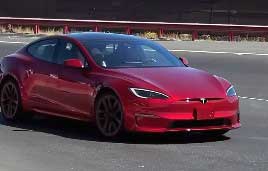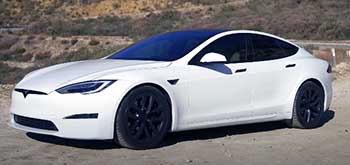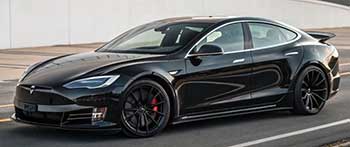
I’ve always been fascinated by Tesla’s ability to push the boundaries of electric vehicles, and the Model S lineup is a prime example of their innovation. In this article,
I’ll explore the Tesla Model S and its high-performance sibling, the Model S Plaid, comparing their features, performance, and value.
My goal is to help you decide which model suits your needs by breaking down their strengths, weaknesses, and real-world usability in a conversational, analytical way.
Whether you’re after efficiency or exhilaration, let’s unpack what makes these cars tick and which one might be your perfect fit.
Comparison Table
| Feature | Tesla Model S | Tesla Model S Plaid |
|---|---|---|
| Horsepower | 670 hp | 1020 hp |
| 0-60 mph | 3.1 seconds | 1.99 seconds |
| Top Speed | 155 mph | 200 mph (with paid upgrade) |
| Range (EPA Estimated) | 405 miles | 396 miles |
| Price (Starting MSRP) | $81,630 | $96,630 |
| Motors | Dual motor AWD | Tri-motor AWD |
| Battery | ~100 kWh | ~95 kWh |
| Drag Coefficient | 0.208 | 0.208 |
| Interior Features | 17-inch touchscreen, premium audio | 17-inch touchscreen, carbon-fiber trim |
| Weight | ~4,900 lbs | 4,828 lbs |
My Experience With Tesla Model S
When I first slid into the driver’s seat of the Tesla Model S, it felt like stepping into the future. The massive 17-inch touchscreen dominating the dashboard was both intimidating and exhilarating. Everything from climate control to navigation is managed through this sleek interface, which responds with the snappiness of a high-end tablet.
The acceleration, even on the standard Model S, is nothing short of thrilling—670 horsepower rockets you from 0 to 60 mph in 3.1 seconds, pinning you to the seat with a grin-inducing surge. It’s not just fast; it’s smooth, silent, and effortless, a hallmark of Tesla’s electric powertrain.
Driving the Model S daily, I appreciated its practicality. The 405-mile EPA-estimated range meant I could go days without plugging in, especially with access to Tesla’s Supercharger network, which adds up to 200 miles of range in just 15 minutes. The cabin is spacious, with room for five adults and a “frunk” for extra storage.
However, the minimalist interior, while modern, felt a bit stark compared to luxury rivals like the Mercedes-Benz EQE. The seats are comfortable but lack the lateral support I’d want for spirited driving, and road noise can creep in on rough surfaces.
What stood out most was the tech. Tesla’s Autopilot, included as standard, made highway drives less taxing with its adaptive cruise control and lane-keeping features. The over-the-air updates kept the car feeling fresh, adding new functionalities without a trip to the service center.
Still, I noticed occasional build quality quirks—like slightly misaligned panels—that reminded me Tesla isn’t perfect. Overall, the Model S blends efficiency, tech, and performance in a way that’s hard to beat for the price.
Pros Of Tesla Model S

- Impressive Range: The 405-mile EPA-estimated range is among the best in the EV sedan class, outpacing competitors like the BMW i5 (around 300 miles). It’s ideal for long road trips or minimizing charging stops.
- Smooth Acceleration: With 670 horsepower, the dual-motor setup delivers a 0-60 mph sprint in 3.1 seconds, offering supercar-like performance without the gas guzzling.
- Advanced Technology: The 17-inch touchscreen is a tech lover’s dream, controlling nearly every function with crisp graphics. Over-the-air updates keep the car evolving.
- Supercharger Network: Tesla’s extensive charging infrastructure makes long-distance travel a breeze, with 250 kW charging speeds adding significant range quickly.
- Practical Design: The hatchback layout and frunk provide 28 cubic feet of cargo space, making it more versatile than traditional sedans.
- Safety Ratings: The Model S has a five-star NHTSA rating, thanks to its low center of gravity and lack of a front engine, enhancing crash safety.
- Lower Starting Price: At $81,630, it’s significantly cheaper than the Plaid, offering great value for performance and range.
Also read: My Thoughts on Ford Edge Vs. Hyundai Tucson
Cons Of Tesla Model S
- Minimalist Interior: The cabin’s simplicity, while sleek, lacks the plush luxury of competitors like the Lucid Air, which boasts richer materials.
- Build Quality Issues: Some owners report minor fit-and-finish problems, like uneven panel gaps, which can detract from the premium feel.
- Less Engaging Handling: Despite its power, the Model S isn’t as fun to corner as a Porsche Taycan, with less steering feedback.
- Basic Seat Design: The seats are comfortable but lack lateral support, which can be noticeable during aggressive driving.
- No Federal Tax Credit: Unlike some EVs, the Model S doesn’t qualify for the $7,500 federal incentive, increasing the effective cost.
- Spartan Rear Seating: The rear seats are upright, and the high floor can make long trips less comfortable for passengers.
- Dependence on Touchscreen: Nearly all controls, including wipers, are managed via the touchscreen, which can be distracting while driving.
Maintenance Tips For Tesla Model S
- Monitor Tire Wear: The Model S’s power can wear tires quickly, especially if you drive aggressively. Check tread depth monthly and rotate tires every 6,000-8,000 miles to ensure even wear.
- Keep Software Updated: Tesla’s over-the-air updates improve performance and add features. Ensure your car is connected to Wi-Fi regularly to receive the latest firmware.
- Clean the Charging Port: Dust and debris can accumulate in the charging port, affecting connectivity. Use a soft cloth and compressed air to keep it clean.
- Inspect Brake Pads: While regenerative braking reduces wear, check pads every 12,000 miles, especially if you disable regen for spirited driving.
- Maintain Cabin Air Filters: Replace the cabin air filter every two years or 25,000 miles to maintain air quality and HVAC efficiency.
- Check Coolant Levels: The battery and motor cooling systems rely on coolant. Have it inspected during annual service to prevent overheating.
- Protect the Touchscreen: Use a microfiber cloth to clean the 17-inch display and avoid harsh chemicals that could damage the coating.
My Experience With Tesla Model S Plaid
The Tesla Model S Plaid is a beast, and I mean that in the best way possible. The first time I floored it in Drag Strip mode, the 1,020 horsepower launched me from 0 to 60 mph in just 1.99 seconds—a sensation that felt like being shot out of a cannon.
The tri-motor setup delivers relentless acceleration, and the “cheetah stance” (where the air suspension lowers the front end) adds a theatrical flair. It’s not just fast; it’s otherworldly, making even supercars like the Porsche Taycan Turbo S feel tame in a straight line.
On the road, the Plaid is a paradox. It’s a 4,828-pound sedan that handles like a much lighter car, thanks to its low center of gravity and torque vectoring. But the yoke steering, while futuristic, took some getting used to—turning tight corners felt awkward at first. The interior is nearly identical to the standard Model S, but the carbon-fiber trim adds a sporty touch. The 396-mile range is slightly less than the standard model, but still impressive for something this powerful.
Daily driving revealed some quirks. The Plaid’s performance comes at the cost of tire wear—I noticed significant tread loss after just 10,000 miles of spirited driving. The cabin is quiet, but the sheer power tempts you to push it, which can be impractical on public roads. Still, the Plaid’s ability to merge raw speed with Tesla’s tech ecosystem (like Autopilot and Supercharging) makes it a unique proposition. It’s not just a car; it’s a statement.
Pros Of Tesla Model S Plaid
- Unmatched Acceleration: The tri-motor setup’s 1,020 horsepower delivers a 0-60 mph time of 1.99 seconds, outpacing most production cars, including the Ferrari SF90.
- High Top Speed: With a paid upgrade, the Plaid hits 200 mph, a rare feat for a sedan, making it a track-day monster.
- Advanced Motor Tech: Carbon-fiber-sleeved rotors allow 20,000 rpm, maintaining 1,000 hp up to top speed, unlike most EVs where power drops off.
- Sporty Styling: The Plaid badge, red calipers, and rear spoiler give it a distinct, aggressive look over the standard Model S.
- Track-Ready Handling: Torque vectoring and a low center of gravity make it surprisingly agile for a 4,828-pound car, with a 1.08g skidpad result.
- Premium Audio: The 22-speaker, 960-watt system delivers crystal-clear sound, perfect for long drives or showing off to passengers.
- Record-Breaking Performance: It set records at Pikes Peak and Laguna Seca, proving its dominance in real-world racing conditions.
Cons Of Tesla Model S Plaid

- Higher Price Tag: Starting at $96,630, it’s $15,000 more than the standard Model S, which may not justify the performance for daily drivers.
- Reduced Range: The 396-mile range is slightly less than the standard Model S, potentially limiting long-distance trips.
- Yoke Steering Challenges: The yoke can feel unnatural in tight maneuvers, and haptic buttons for indicators are less intuitive than stalks.
- Tire Wear Issues: Aggressive driving can bald tires in as little as 10,000 miles, leading to costly replacements (up to $1,800).
- Overkill for Daily Use: The extreme power is hard to utilize legally on public roads, making the Plaid feel excessive for commuting.
- Similar Interior: Aside from carbon-fiber trim, the cabin is nearly identical to the standard model, lacking unique luxury touches.
- Stability Control Limits: The undefeatable stability control can intervene abruptly, reducing fun at the handling limit.
Maintenance Tips For Tesla Model S Plaid
- Check Tires Frequently: The Plaid’s power eats tires fast—inspect tread every 5,000 miles and consider high-performance tires for better durability.
- Update Software Regularly: Like the standard model, ensure Wi-Fi connectivity for over-the-air updates to optimize performance and fix bugs.
- Clean Charging Port: Keep the gull-wing charge port free of debris with a soft brush to ensure reliable Supercharging.
- Monitor Brake Wear: The Plaid’s aggressive driving style may wear brakes faster; inspect pads every 10,000 miles.
- Replace Air Filters: Swap cabin air filters every 18 months or 20,000 miles to maintain climate control efficiency in the high-performance cabin.
- Inspect Suspension: The air suspension’s “cheetah stance” feature stresses components—check for wear during annual service.
- Coolant Maintenance: Ensure the tri-motor cooling system is checked yearly to handle the higher heat output from 20,000 rpm motors.
Read more: My Thoughts on Acura Integra Vs. Honda Accord
Comparison With Other Brands
- Lucid Air Sapphire: Offers up to 512 miles of range and similar 0-60 mph times (2.2 seconds), but its $249,000 price dwarfs the Plaid’s cost. The Air’s interior feels more luxurious but lacks Tesla’s Supercharger network.
- Porsche Taycan Turbo S: Matches the Plaid’s 2.1-second 0-60 mph sprint but tops out at 161 mph and 222 miles of range. Its handling is sharper, but the $209,000 price and less practical hatchback make it less versatile.
- Mercedes-AMG EQS 4Matic+: With 751 hp and a 107.8-kWh battery, it’s slower (3.4 seconds to 60 mph) but offers a yacht-like interior. Its 280-mile range and $147,550 price make it less competitive for performance.
- BMW i5 M60: Delivers 590 hp and a 300-mile range, with a 3.7-second 0-60 mph time. Its interior is plusher, but at $84,100, it can’t match the Model S’s range or power.
- Audi e-tron GT: Produces 522 hp and a 3.9-second 0-60 mph time with a 238-mile range. Priced at $104,900, it’s refined but lags in performance and efficiency compared to both Model S variants.
Frequently Asked Questions (FAQ)
The Model S Plaid has a tri-motor setup with 1,020 hp, achieving 0-60 mph in 1.99 seconds, compared to the Model S’s dual-motor 670 hp and 3.1 seconds. The Plaid offers a 200 mph top speed (with upgrade) but has a slightly lower 396-mile range versus the Model S’s 405 miles.
The Plaid’s tri-motor system, carbon-fiber-sleeved rotors, and 20,000 rpm capability deliver unmatched acceleration and sustained power. It also features a rear spoiler, red calipers, and carbon-fiber trim, distinguishing it from the standard Model S’s dual-motor setup.
It depends on your priorities. If you crave record-breaking acceleration and track-ready performance, the Plaid’s worth the $15,000 premium. For daily driving, the standard Model S’s range and power are often sufficient, offering better value.
The Plaid’s $96,630 starting price is relatively low for its 1,020 hp and performance, thanks to Tesla’s efficient production and economies of scale. Compared to rivals like the $209,000 Taycan Turbo S, it’s a bargain for the speed.
Conclusion: For Tesla Model S And Tesla Model S Plaid
You’re now armed with the full picture of the Tesla Model S and Model S Plaid, two EVs that redefine what a sedan can do. If you want a practical, long-range cruiser with blistering speed, the standard Model S delivers incredible value at $81,630. But if you’re chasing the ultimate thrill—acceleration that rivals supercars and a 200 mph top speed—the Plaid is your ticket, even if it’s overkill for daily drives. Weigh your need for speed against budget and practicality, and you’ll find the right fit. Which one’s calling your name?

